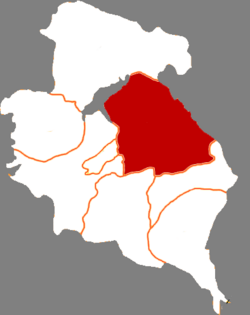Dongxiang Autonomous County
Dongxiang Autonomous County
东乡族自治县 | |
|---|---|
 The northwestern edge of Dongxiang Autonomous County (Hetan Township) seen from across the Daxia River from the neighboring Linxia County | |
 Dongxiang in Linxia | |
 Linxia in Gansu | |
| Coordinates: 35°39′50″N 103°23′21″E / 35.6638°N 103.3893°ECoordinates: 35°39′50″N 103°23′21″E / 35.6638°N 103.3893°E | |
| Country | People's Republic of China |
| Province | Gansu |
| Autonomous prefecture | Linxia |
| Area | |
| • Total | 1,510 km2 (580 sq mi) |
| Elevation | 2,000 m (7,000 ft) |
| Highest elevation | 2,664 m (8,740 ft) |
| Lowest elevation | 1,736 m (5,696 ft) |
| Population (2020) | |
| • Total | 381,700 |
| • Density | 250/km2 (650/sq mi) |
| • Dongxiang people | 335,500 (87.9%) |
| Time zone | UTC+8 (China Standard) |
| Postal code | 731400 |
| Website | www |
Dongxiang Autonomous County (simplified Chinese: 东乡族自治县; traditional Chinese: 東鄉族自治縣; pinyin: Dōngxiāngzú Zìzhìxiàn; Santa: Dunxianzu Zizhixien) is an autonomous county in the Linxia Hui Autonomous Prefecture, province of Gansu of the People's Republic of China. It was established as a Dongxiang ethnic autonomous area in 1950.[2] Historically, Dongxiang has long been directly under the jurisdiction of Linxia. During the Republic of China (1912–1949) period, its area was divided between the surrounding counties.[3]

Its population in 2020 was 381,700, 88% of whom belonging to the Dongxiang minority group. As of 1993, half of the total Dongxiang minority population lived in the county.[4][5]
At least until the end of the 20th century, Dongxiang County was very impoverished and undeveloped, having a literacy rate of just 15%, the lowest in China.[6] In 2017, it had the highest poverty rate of Gansu, already the poorest province in China.[3]
Dongxiang County has a typical Loess Plateau landscape, with numerous gullies and mountains and a dry climate.
Administrative divisions[]
Dongxiang Autonomous County is divided to 8 towns and 16 townships.[7]
- Towns
|
|
- Townships
|
|
Culture[]
Dongxiang County is the birthplace and center of Dongxiang culture.[3] It's specialty food includes Pinghuo, a dish of steamed lamb.[8][9]
Transport[]
Sources[]
- ^ Weixian, Yin (1998). "Dongxiang Autonomous County (Gansu Province)". Chinese Education & Society. 31 (3): 53–76. doi:10.2753/CED1061-1932310353.
- ^ Schwarz, Henry G. (1984). The Minorities of Northern China: A Survey. Western Washington. ISBN 978-0-914584-17-9.
- ^ a b c "县情概况-欢迎访问东乡族自治县人民政府". www.dxzzzx.gov.cn. Retrieved 2021-03-26.
- ^ Chuluu, Üjiyediin (1994). Introduction, Grammar and Sample Sentences for Dongxiang. University of Pennsylvania, Department of Asian and Middle Eastern Studies.
- ^ Du, Ruofu; Tu, Jo-fu; Yip, Vincent F. (1993). Ethnic Groups in China. Science Press. ISBN 978-7-03-003325-3.
- ^ Feng, Associate Professor in the Department of Sociology Wang (1996-08-08). China: The Many Facets Of Demographic Change. Avalon Publishing. ISBN 978-0-8133-9002-4.
- ^ "统计用区划代码 www.stats.gov.cn" (in Chinese). XZQH. Retrieved 2012-05-26.
- ^ "东乡平伙-欢迎访问东乡族自治县人民政府". www.dxzzzx.gov.cn. Retrieved 2021-03-26.
- ^ "最有家乡风情和记忆的羊肉平伙_政务_澎湃新闻-The Paper". www.thepaper.cn. Retrieved 2021-03-26.
| Wikimedia Commons has media related to Dongxiang Autonomous County. |
- Dongxiang Autonomous County
- Autonomous counties of the People's Republic of China
- County-level divisions of Gansu
- Dongxiang people
- Gansu geography stubs
